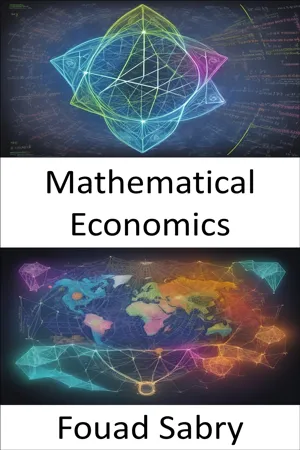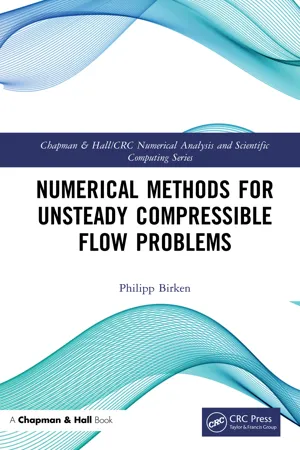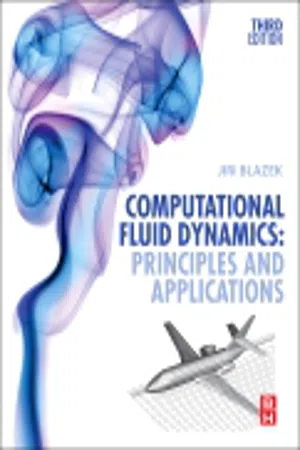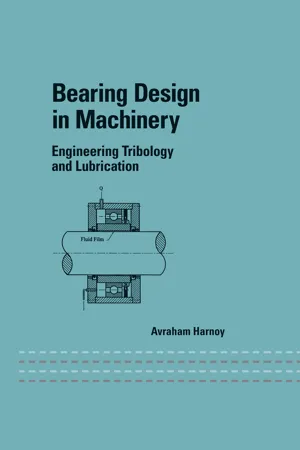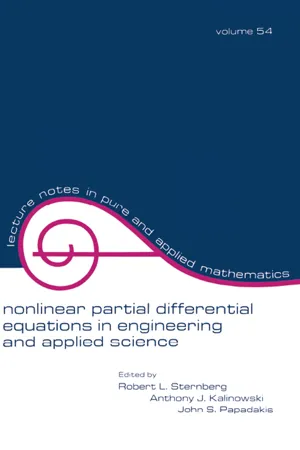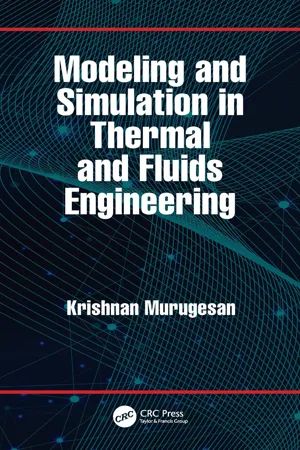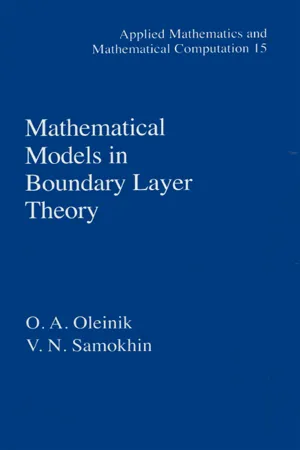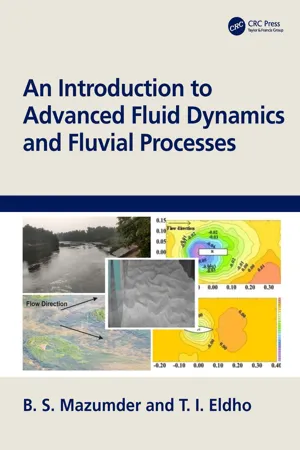Technology & Engineering
Navier Stokes Cylindrical
The Navier-Stokes equations in cylindrical coordinates are a set of partial differential equations that describe the motion of fluid substances. They are used to analyze fluid flow in cylindrical geometries, such as pipes and tubes. These equations take into account the conservation of mass, momentum, and energy, and are fundamental in the study of fluid dynamics.
Written by Perlego with AI-assistance
Related key terms
Related key terms
1 of 4
Related key terms
1 of 3
10 Key excerpts on "Navier Stokes Cylindrical"
- eBook - ePub
Mathematical Economics
Mastering Mathematical Economics, Navigating the Complexities of Economic Phenomena
- Fouad Sabry(Author)
- 2023(Publication Date)
- One Billion Knowledgeable(Publisher)
Chapter 2: Navier–Stokes equations
The Navier–Stokes equations (/nævˈjeɪ stoʊks/ nav-YAY STOHKS) are partial differential equations which describe the motion of viscous fluid substances, Claude-Louis Navier and George Gabriel Stokes were the namesakes. They were both French engineers and physicists.They are the culmination of decades of research and incremental theory development, spanning from 1822 (Navier) to 1842-1850 (Stokes).Momentum conservation and balancing are quantitatively expressed by the Navier-Stokes equations for Newtonian fluids. An equation of state connecting pressure, temperature, and density is sometimes provided alongside them. Assuming that the stress in the fluid is equal to the product of a diffusing viscous component (proportional to the gradient of velocity) and a pressure term, they result from applying Isaac Newton's second law to fluid motion. The Navier-Stokes equations are similar to the Euler equations, but the Euler equations only model inviscid flow, whereas the Navier-Stokes equations also account for viscosity. With this trade-off in mathematical structure comes the improved analytic features of the Navier-Stokes, which are a parabolic equation (e.g. they are never completely integrable).The physics of many phenomena of scientific and engineering interest may be described by the Navier-Stokes equations, making them a useful tool. You may use them to simulate everything from weather to ocean currents to water flow in a conduit to air flow over a wing. Aircraft and automobile design, blood flow research, power plant construction, environmental impact assessment, and many more fields all benefit from the full and simplified Navier-Stokes equations. They can be used to model and analyze magnetohydrodynamics when coupled with Maxwell's equations.In a strictly mathematical sense, the Navier-Stokes equations are also of enormous interest. The existence of smooth solutions in three dimensions, that is, solutions that are endlessly differentiable (or even just limited) at all locations in the domain, has not been established, despite the fact that they have a broad variety of useful applications. This is known as the existence and smoothness problem for Navier-Stokes equations. For a solution or counterexample, the Clay Mathematics Institute is offering a million dollars. They consider this to be one of the seven most important open issues in mathematics. - Philipp Birken(Author)
- 2021(Publication Date)
- Chapman and Hall/CRC(Publisher)
Chapter 2The governing equations
We will now describe the equations that will be used throughout this book. The mathematical models employed in fluid mechanics have their basis in continuum mechanics, which means that it is not molecules that are described, but a large number of those molecules that act as if they were a continuum. Thus velocities, pressure, density, and similar quantities are of a statistical nature and say that on average, at a certain time, the molecules in a tiny volume will behave in a certain way. The mathematical model derived through this approach are the Navier-Stokes equations. The main component of these is the momentum equation, which was found in the beginning of the 19th century independently of each other by Navier [211 ], Stokes [261 ], Poisson [225 ], and de St. Venant [69 ]. During the course of the century, the equations were given more theoretical and experimental backing, so that by now, the momentum equation together with the continuity equation and the energy equation are established as the model describing fluid flow.This derivation also shows one limitation of the mathematical model, namely for rarefied gases as in outer layers of the atmosphere, the number of molecules in a small volume is no longer large enough to allow statistics.From the Navier-Stokes equations, a number of important simplifications have been derived, in particular the incompressible Navier-Stokes equations, the Euler equations, the shallow water equations or the potential flow equations. We will discuss in particular the Euler equations, which form an important basis for the development of discretization schemes for the Navier-Stokes equations, as well as an already very useful mathematical model in itself.2.1 The Navier-Stokes equationsThe Navier-Stokes equations describe the behavior of a Newtonian fluid. In particular, they describe turbulence, boundary layers, as well as shock waves and other wave phenomenas. They consist of the conservation laws of mass, momentum and energy. Thus they are derived from integral quantities, but for the purpose of analysis, they are often written in a differential form. A more detailed description can be found for example in the textbooks of Chorin and Marsden [59 ] and Hirsch [135- eBook - ePub
Computational Fluid Dynamics
Principles and Applications
- Jiri Blazek(Author)
- 2015(Publication Date)
- Butterworth-Heinemann(Publisher)
Section A.1 .In some instances, for example, in turbomachinery applications or in geophysics, the control volume is rotating (usually steadily) about some axis. In such a case, the Navier-Stokes equations are transformed into a rotating frame of reference . As a consequence, the source termQ→has to be extended by the effects due to the Coriolis and the centrifugal force [8 ]. The resulting form of the Navier-Stokes equations may be found in Section A.4 . In other cases, the control volume can be subjected to translation or deformation. This happens, for instance, when fluid-structure interaction is investigated. Then, the Navier-Stokes equations (2.19 ) have to be extended by a term, which describes the relative motion of the surface element dS with respect to the fixed coordinate system [9 ]. Additionally, the so-called geometric conservation law has to be fulfilled [10 –12 ]. We present the appropriate formulation in Section A.5 .The Navier-Stokes equations represent in three dimensions a system of five equations for the five conservative variables ρ , ρu , ρv , ρw , and ρE . But they contain seven unknown flow field variables, namely: ρ , u , v , w , E , p , and T . Therefore, we have to provide two additional equations, which have to formulate thermodynamic relations between the state variables. For example, the pressure being expressed as a function of the density and temperature, and the internal energy or the enthalpy being given as a function of the pressure and temperature. Beyond this, we have to provide the viscosity coefficient μ and the thermal conductivity coefficient k - eBook - ePub
Bearing Design in Machinery
Engineering Tribology and Lubrication
- Avraham Harnoy(Author)
- 2002(Publication Date)
- CRC Press(Publisher)
5Basic Hydrodynamic Equations5.1 NAVIER-STOKES EQUATIONSThe pressure distribution and load capacity of a hydrodynamic bearing are analyzed and solved by using classical fluid dynamics equations. In a thin fluid film, the viscosity is the most important fluid property determining the magnitude of the pressure wave, while the effect of the fluid inertia (ma) is relatively small and negligible. Reynolds (1894) introduced classical hydrodynamic lubrication theory. Although a lot of subsequent research has been devoted to this discipline, Reynolds’ equation still forms the basis of most analytical research in hydro-dynamic lubrication. The Reynolds equation can be derived from the Navier– Stokes equations, which are the fundamental equations of fluid motion.The derivation of the Navier–Stokes equations is based on several assumptions, which are included in the list of assumptions (Sec. 4.2 ) that forms the basis of the theory of hydrodynamic lubrication. An important assumption for the derivation of the Navier–Stokes equations is that there is a linear relationship between the respective components of stress and strain rate in the fluid.In the general case of three-dimensional flow, there are nine stress components referred to as components of the stress tensor. The directions of the stress components are shown in Fig 5-1 .FIG . 5-1 Stress components acting on a rectangular fluid element.The stress components σx , σy , σz are of tension or compression (if the sign is negative), as shown in Fig. 5-1 . However, the mixed components τxy , τzy , τxz are shear stresses parallel to the surfaces.It is possible to show by equilibrium considerations that the shear components are symmetrical:τxy = τyx , τyz = τzy , τxz = τzx (5-1)Due to symmetry, the number of stress components is reduced from nine to six. In rectangular coordinates the six stress components areA fluid that can be described by Eq. (5-2) is referred to as Newtonian fluid. This equation is based on the assumption of a linear relationship between the stress and strain-rate components. For most lubricants, such a linear relationship is an adequate approximation. However, under extreme conditions, e.g., very high pressure of point or line contacts, this assumption is no longer valid. An assumption that is made for convenience is that the viscosity, µ, of the lubricant is constant. Also, lubrication oils are practically incompressible - eBook - ePub
- Robert L. Sternberg, Anthony J. Kalinowski, John S. Papadakis(Authors)
- 2017(Publication Date)
- CRC Press(Publisher)
This paper presents an initial stage of work attempting to construct a numerical scheme for the first step of this iterative procedure–solving the stationary Navier-Stokes equations for a two-dimensional gas flow in a bounded domain when the density and viscosity are known nonvanishing functions of space coordinates. The flow can be either plane or cylindrical, axially-symmetric. §2. FORMULATION OF THE PROBLEM IN TERMS OF DIFFERENTIAL EQUATIONS We shall consider a stationary axially-symmetric flow of a viscous gas with variable density and viscosity in a bounded cylindrical domain Ω. This is a more general case of the two bidimensional cases, since the plane case is obtainable from the cylindrical one as a special subcase for, roughly speaking, a vanishing curvature, i.e., when all terms containing r ˗α,α ≥ 1 are equal to zero, where r denotes the radius. Before imposing the condition of axial symmetry, the governing Navier-Stokes equations in Ω ⊂ R 3 can be written using Cartesian coordinates (x 1,x 2,x 3). as ρ v μ ∂ v ν ∂ x μ = − ∂ p ∂ x ν + ∂ ∂ x μ { η (∂ v ν ∂ x μ + ∂ v μ ∂ x ν) } + ∂ ∂ x ν { (ζ − 2 3 η) ∂ v α ∂ x α } + f ν (1) ∂ ∂ x μ (ρ v μ) = 0 (2) with the boundary. condition v ν | ∂ Ω = 0 o r, m o r e g e n e r a l l y v ν | ∂ Ω = t ν (3) where: μ, ν, α = 1, 2, 3 x → = (x 1, x 2, x 3) v → = (v 1 (x →), v 2 (x →), v 3 (x →)), gas. velocity p = p (x →), pressure ρ = ρ (x →), gas density η = η (x →), dynamic viscosity ζ = ζ (x →), second viscosity f → = (f 1 (x →), f 2 (x →), f 3 (x →)), external force, in particular f → = ρ g → g → = (0, 0, − g), acceleration of. gravity t → = t → (x → : x → ∈ ∂ Ω), known function The velocity and pressure are unknowns of the system (1) – (2) while the other variables are treated as known functions of position x →. The system is not typically elliptic and this fact leads to certain inconveniences connected with the pressure appearing in Eq. (1) - eBook - ePub
- Ronald L. Panton(Author)
- 2024(Publication Date)
- Wiley(Publisher)
The more sophisticated kinetic theory gives which is roughly correct. 6.6 NAVIER–STOKES EQUATIONS The continuity equation, the momentum equations with Newton’s viscosity law, and an energy equation with Fourier’s conduction law are commonly referred to as the Navier–Stokes equations. Alternatively, in incompressible flow, we also use the term to apply to the same equations where the density, viscosity, and thermal conductivity are constant. The Navier–Stokes equations are easily found by substituting Eqs. 6.8 and 6.33 into Eqs. 5.44 and 5.62. Appendix C contains these equations in rectangular, cylindrical, and spherical coordinates. (6.40) (6.41) (6.42) The Navier–Stokes equations are completed by specifying thermodynamic state equations and and transport relations and 6.7 CONCLUSIONS A fluid flow problem for a general fluid is governed by several equations. First, there are the basic relations for continuity, three momentum equations and an energy relation. Second, there are the constitutive equations for the surface stresses and the heat flux. These equations are not basic, but they do apply to groups of substances. Third, the thermodynamics of the fluid must be specified through two equations of state and The pressure, in general, is a thermodynamic property, but in incompressible flow it acts only as a force. Various transport coefficients are introduced in the constitutive relations. They are quasi-thermodynamic properties that depend on the composition of the fluid and its thermodynamic state. A constitutive law relates the stress tensor to the strain tensor, and includes viscosity coefficients. The simplest liner law is Newton’s viscosity law - Krishnan Murugesan(Author)
- 2022(Publication Date)
- CRC Press(Publisher)
Momentum conservation equations in the primitive variable form are very commonly employed in the solution of CFD-related problems with and without heat and species transfer. As was discussed earlier in the previous sections, the pressure term which appears in the momentum equations is not present in the continuity equation and it contributes indirectly to the mass conservation relation. Hence, researchers have come up with different types of solution algorithms for the Navier-Stokes equations in primitive variable form. In CFD applications when the pressure field is not required compared to fluid friction and heat transfer, then scientists have resorted to a set of momentum equations without the pressure term. Stream function-velocity and stream function-vorticity are the other forms of Navier-Stokes equations. As it is well understood from basic fluid mechanics, the stream function does not contribute any engineering design parameters directly and it is used to visualize the flow pattern in a given flow domain. Though the solution of the above-mentioned two types of formulations is relatively easier than the primitive variable form of Navier-Stokes equations, the resulting field variables are not directly useful in any simulation analysis. Of course, it has to be remembered that any different type of formulation of Navier-Stokes equations have to be obtained only from the primitive variable form because they are the fundamental equations that represent the natural setting of mass and momentum conservation principles in a given flow domain. Velocity-vorticity form of Navier-Stokes equations can be derived from the primitive variable form of Navier-Stokes equations to analyze problems wherein the main focus is only heat transfer and species transfer or other types of parameters that influence fluid flow. For example, the use of nanofluid as the working fluid in the domain and the effect of body forces such as magnetic force can be investigated easily in this type of equation as there is no need to employ a special type of solution algorithm to resolve the pressure term. In this set of equations, the pressure term does not appear and influence directly, thus making the solution algorithm straightforward. However, these equations cannot yield correct results unless the vorticity boundary conditions are enforced effectively on the boundaries. There exists coupling between the velocity and vorticity fields in these equations. The generalized derivation of these equations will be explained in detail in the following section.7.3.1 Derivation of Velocity-Vorticity Equations as Generalized Formulation
The Navier-Stokes equations for laminar, incompressible Newtonian fluid flow in primitive variables form can be represented in vector form asContinuity Equation∇ ⋅ V = 0(7.27) Momentum Equation+∂ V∂ tV = −V ⋅ ∇1∇ P + νρ+∇ 2VF b+F E(7.28) whereF b,F E- eBook - ePub
- David Ting(Author)
- 2016(Publication Date)
- Academic Press(Publisher)
Navier-Stokes equations for compressible turbulent flows of an ideal gas Derive the Navier-Stokes equations for compressible turbulent flows of an ideal gas. Problem 2.5. Reynolds stresses A blob of dye is dropped into a pool of agitated water. Assume the blob is a sphere in the middle of the pool of water and that the pool of water has a zero mean velocity. How do the Reynolds stresses affect the dispersion of the blob of dye? Problem 2.6. Sampling oscillating flow The velocity of moving water in a water channel is controlled such that its magnitude oscillates between 0.5 m/s and 1 m/s periodically at 0.25 Hz. A hot-film is used to quantify the flow. What should the sample rate and sample size be? How can you verify that these settings are sufficient? Back up your solution using plots, etc. References Çengel YA, Cimbala JM. Fluid Mechanics: Fundamentals and Applications. third ed. New York : McGraw-Hill ; 2013. Choudhuri AR. The Physics of Fluids and Plasmas. Cambridge : Cambridge University Press ; 1998. Currie IG. Fundamental Mechanics of Fluids. New York : McGraw-Hill ; 1974. Davidson PA. Turbulence: An Introduction for Scientists and Engineers. New York : Oxford University Press ; 2004. Fox RW, Pritchard PJ, McDonald AT. Introduction to Fluid. Mechanics. seventh ed. USA : John Wiley & Sons ; 2009. Garde RJ. Turbulent Flow. third ed. UK : New Age Science ; 2010. Haller G. Lagrangian coherent structures. J. Fluid Mech. 2015 ; 47 : 137 – 162. Hinze JO. Turbulence. USA : McGraw-Hill ; 1959. Hinze JO. Turbulence. second ed. USA : McGraw-Hill ; 1975. Reynolds O. On the dynamical theory of incompressible viscous fluids and the determination of the criterion. Philos. Trans. R. Soc. Lond. Ser. A. 1895 ; 186 : 123 – 164. Wilcox DC. Turbulence Modeling for CFD. third ed. USA : DCW ; 2006. Wilson, D.J., 1989. Mec E 632: Turbulent Fluid Dynamics, Lecture Notes, University of Alberta, Edmonton. Sync Reading Stream What's this? - eBook - ePub
- O.A. Oleinik, V.N. Samokhin(Authors)
- 2018(Publication Date)
- Chapman and Hall/CRC(Publisher)
CHAPTER 1 The Navier-Stokes Equations and the Prandtl SystemIn this chapter we derive the equations of the Prandtl system, which is the main object of our further investigation. This system is obtained as a simplification of the Navier-Stokes system and describes the motion of a fluid with small viscosity about a solid body in a thin layer which is formed near its surface owing to the adhesion of the viscous fluid to the solid surface. In this chapter we also formulate the main boundary value problems corresponding to various physical conditions of fluid dynamics. We also write out some transformations of the variables commonly used for the examination of these problems. We discuss the separation of the boundary layer and the problem of closeness between the solutions of the Prandtl system and those of the Navier-Stokes system.As shown by experiment, a boundary layer is also formed in the case of non-Newtonian fluids. Below, the corresponding equations are written out for fluids with stresses expressed through powers of deformation velocities (Ostawald de Waele media); in some sense, these equations generalize the Prandtl system. Finally, a boundary layer system is obtained for electrically conducting fluids in the presence of magnetic field.1.1 Derivation of the Prandtl SystemThe Navier-Stokes equations represent the basic mathematical model of a viscous incompressible flow. Assume that the motion of a fluid occupying a three-dimensional region is characterized by the velocity vector V = (u, υ, w), where u, υ, w are the projections of V onto the coordinate axes x, y, z, respectively. For a nonstationary flow of a viscous incompressible homogeneous fluid, in the absence of mass forces, the Navier-Stokes system can be written in the form+ u∂ u∂ t+ υ∂ u∂ x+ w∂ u∂ y= −∂ u∂ z1 ρ+ ν Δ u ,∂ p∂ x+ u∂ υ∂ t+ υ∂ υ∂ x+ w∂ υ∂ y= −∂ υ∂ z1 ρ+ ν Δ υ ,∂ p∂ y+ u∂ w∂ t+ υ∂ w∂ x+ w∂ w∂ y= −∂ w∂ z - B. S. Mazumder, T. I. Eldho(Authors)
- 2023(Publication Date)
- CRC Press(Publisher)
U in front of the body. The kinetic energy contained in the velocity field of the vortex street must be continually created as the body moves through the fluid.FIGURE 4.8 Sketch of Karman Vortex Street past a cylinder.4.6 Basic Equations of Laminar Flow (Navier–Stokes Equations)
To obtain a complete and primary understanding of the fluid dynamics problems, the general governing equations of continuity, momentum and energy need to be known. All the fluid motions, whether laminar or turbulent, are governed by those dynamical equations. The complete solution for those equations is not possible because of intractable mathematical difficulties due to high nonlinearity and complexity. However, these equations are solvable subject to great oversimplification in some individual cases.For a Newtonian fluid (fluids with shear stress proportional to the velocity gradient), the momentum and continuity equations can be written using Cartesian tensor notations as:(4.32)ρ f=Du iD tρ fX i+∂σi j∂x j(4.33)+Dρ fD tρ f∇ .u j= 0where, t is the time,D=D t∂+∂ tu j∂, ∇ ≡∂x j∂∂x jx iis the Cartesian coordinates,u iis thex icomponent of fluid velocity andX iis the body force (such as gravity force),is the density of the fluids. The quantityρ fσis the stress on the fluid and is given byi j(4.34)σ= − pi jδ+i jμ f()+∂u i∂x j∂u j∂x iThe above relation is the constitutive equation for a Newtonian fluid. Here p is the fluid pressure,μ fis the viscosity, andδi j
Explore more topic indexes
Explore more topic indexes
1 of 6
Explore more topic indexes
1 of 4
